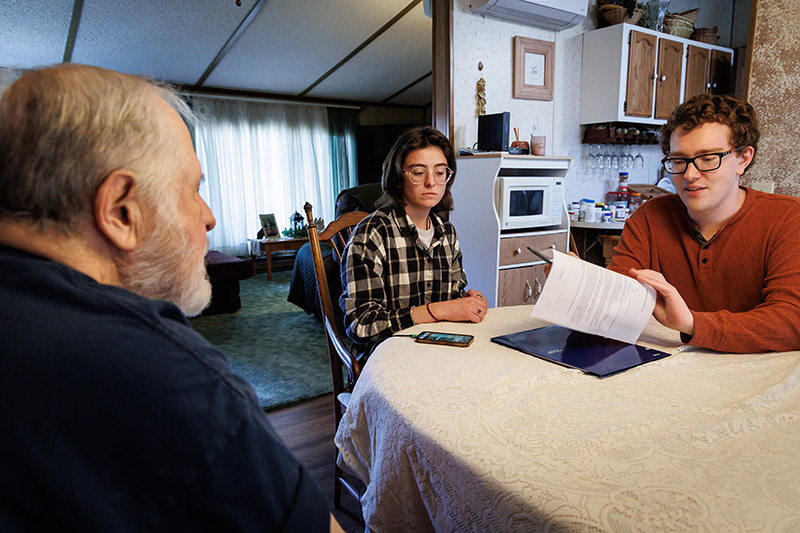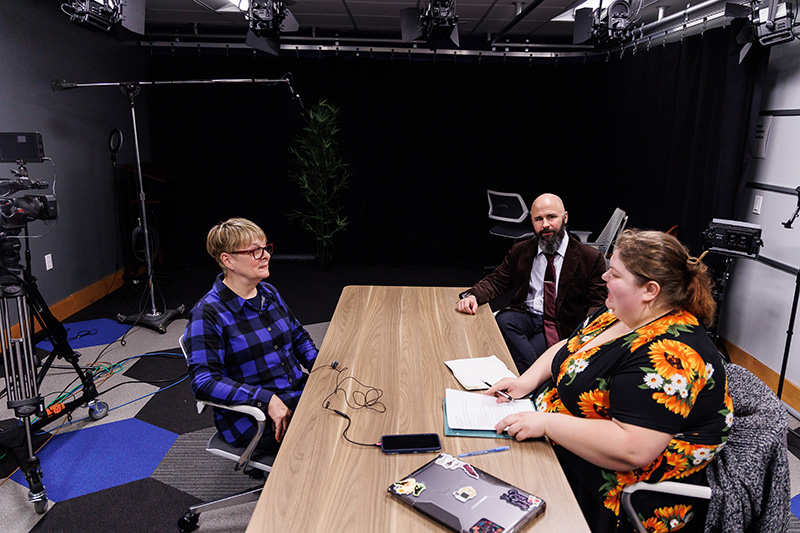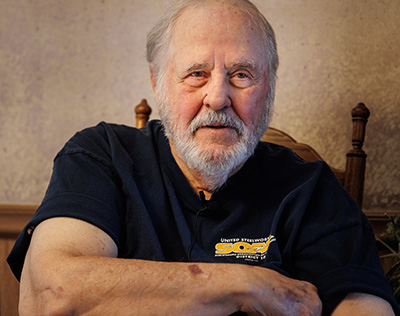
Graeme Olson ’24 and Abigail Ortega ’24 interview Mike Dzwonczyk, former steel worker and current board chair of the Steelworkers’ Archives, for their public history course “Oral History and Podcasting.” (Photo: John Kish IV)
This past semester, students in Richard Anderson’s “Oral History and Podcasting” course partnered with the National Museum of Industrial History at the Steelworkers’ Archives in South Bethlehem to create podcasts based on their interviews with former employees of Bethlehem Steel.
The assignment was an exercise in what’s known as public history, which is history for general, non-academic audiences and practiced by many museum professionals and historic site interpreters as well as arts and humanities professionals, explains Anderson, who is an assistant professor of history and public history at Moravian University.
“What’s exciting about this course is that the students are not simply analyzing primary sources; they are actually creating their own primary sources,” Anderson says. “And they’re doing it knowing that their podcast transcripts will be deposited in an archive where they’ll be available for future researchers.”
A unique aspect of public history is that it follows the lead of the narrator, whom oral historians call the traditional interview subject. The narrator is the one telling the story rather than simply being studied from afar by an academic scholar.
The students chose their narrators at an event for the members of the Steelworkers’ Archives at the National Museum of Industrial History, where former workers and archive employees gave presentations and spoke briefly about their experiences.

Two students, Lauren Amori ’24 and Sabrina Moody ’24, met and subsequently interviewed Rose Meixell-Neith, who worked for Bethlehem Steel from 1975 to 1979, and was one of the few women to work in the steel foundry.
“It was interesting because Rose said the older men treated her like a sister or a daughter, but the younger men saw her as the average woman on the street,” Amori says. “She felt that women coming to work at the foundry might have made some of the men think that their safe place was taken away.”
Moody was eager to dive into the public history project because she fields a lot of historical questions working as a museum storyteller for Historic Bethlehem.
“I get a lot of people coming up to me and sharing their memories, but this project is much different,” Moody says. “I have thoroughly enjoyed learning how to do a more formal interview and how to use the technology required to edit the transcripts and the audio equipment to create the podcast.”

Graeme Olson ’24 liked learning the technology as well. He and Abigail Ortega ’24 spoke with former steel worker and current board chair of the Steelworkers’ Archives, Mike Dzwonczyk.
“Through this project, I am beginning to learn new digital skills, such as the program Adobe Audition,” Olson says. “I have a YouTube channel and have some familiarity with editing skills, but I feel as though I am learning something new by going more in-depth with editing audio.”
Olson also enjoyed learning about Dzwonczyk’s time as a union representative who worked in the blast furnace and about industrial history in general.
“My favorite thing about this project was getting to learn from someone who helped build this country,” Olson says. “I have a lot of respect for the workers who put their heart and soul into this work, because it’s something I couldn’t imagine myself doing.”
Ortega, who plans to be a high school social studies teacher when she graduates, didn’t know what public history was before doing this project but found that it aligns with her own interests and predilections.
“Public history is a lot of what I enjoy about history. It brings ordinary people into the subject of history as the subjects themselves, and it makes history more accessible to more people by not following the often-academic presentation of history, which intimidates a lot of people,” Ortega says.—Steve Neumann ’94, G’18